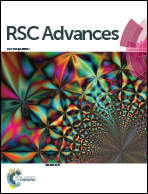A novel hydrophilic fluorescent probe for Cu2+ detection and imaging in HeLa cells†
Abstract
Copper is an essential element in living systems and plays an important role in human physiology; therefore, methods to detect the concentration of copper ions in living organisms are important. Herein, we report a highly water-soluble naphthalimide-based fluorescent probe that can be used for the detection of Cu2+. The probe, BNQ, has high selectivity and sensitivity. The fluorescence intensity of the probe at 520 nm was visible to the naked eye under a UV lamp; upon the gradual addition of Cu2+, there was a colour change from green to nearly colourless. Furthermore, the detection limit of BNQ for Cu2+ was 45.5 nM. The detection mechanism was investigated using a Job's plot and density functional theory (DFT) calculations. In addition, owing to great biocompatibility, we were able to successfully use BNQ to detect Cu2+ in living HeLa cells with low toxicity.



 Please wait while we load your content...
Please wait while we load your content...